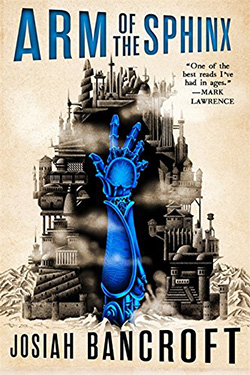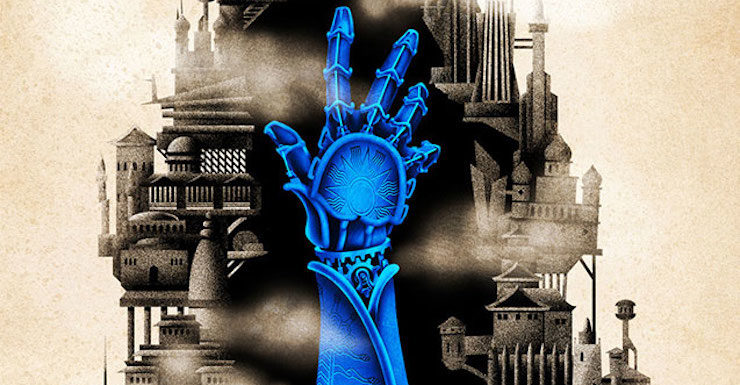On the back of the outstanding surprise that was Senlin Ascends, The Books of Babel only get better as Arm of the Sphinx expands its every aspect massively, like a balloon blown by a breathless baboon. The scope of the story, the extent of the setting and the small matter of the last narrative’s serviceable secondary characters—all are brilliantly embiggened in this superlative successor.
When schoolteacher Thomas Senlin lost track of his dear Marya at the foot of the Tower of Babel, to which otherworldly wonder they’d come to spend their hard-earned honeymoon, he imagined it would be a simple enough thing to find her before forging on with the rest of their R&R. How wrong he was. Instead, he was led on a merry chase to and through a few of the distinctive ringdoms that make up the aforementioned monolith, only to find himself drawn into the disputes of desperate men again and again. Unfortunately, for all the pains he’s taken, Senlin is no closer now to reuniting with his wife that he was on that first frightful night.
Buy the Book


Arm of the Sphinx (The Books of Babel)
“It has been a year since I wandered away from her and she from me,” the poor fellow laments early on in Arm of the Sphinx, “a year since I began turning in this maze, expecting to see the end appear around every new corner.” Alas for him that it hasn’t, and that it isn’t likely to for a good while longer; the Tower certainly isn’t going to give up its secrets so easily.
As this and the rather harsh reality of his new situation sinks in, Senlin, having “missed a reunion with his wife by a matter of hours and stolen first a painting and then a ship,” honestly hasn’t the first clue what to do:
“I thought that once I had a ship, everything would fall into place. I certainly didn’t think I was giving up bookkeeping to take up piracy. I just pictured this straight line of events. I thought we’d fly to Pelphia, find my wife, carry us all home, and that would be the end of it.”
“Us all” is the unlikely lot Senlin has taken on to crew the Stone Cloud, the ship he so perilously pinched at the end of Senlin Ascends. There’s Senlin’s former confidante Adam, whose various betrayals have shaken the foundation of their relationship; there’s Adam’s of late liberated sister Voleta, the free-spirited acrobat whose bond to her brother is breaking now that there’s nobody between them to blame their problems on; there’s Iren, the chain-bearing brute whose hard surface is softening because of her friendship with vulnerable Voleta; and last but not least, there’s Senlin’s second, Mister Winters, whose almost magical mechanical arm links her to the Sphinx, “a bugaboo that airmen blamed for inconvenient gusts, or stubborn fog, or morning frost on the privy seat.” Few but she even believe the Sphinx exists, but Mister Winters insists.
Needless to say, Senlin’s isn’t a huge crew, but it’ll have to do. However, captaining an aircraft is a completely different kettle of fish than supervising the classes of kids he had in the past, and it presents a particular challenge in that these men and women have come to mean more to him than he had imagined. To wit, Arm of the Sphinx sees Senlin suffering a crisis of conscience, “wrestling with the morality of imperilling his friends for the sake of his wife.” Add to that the fact that he’s haunted. The spectre of his dear wife is with him always, and I dare say there’s something more than imagination at play:
“He had tried to remain as he was and become only what he must. He had tried to be the gentleman pirate, the scholarly cad, and had failed on both counts. Perhaps his stubborn duplicity had contributed to his sickness, had stoked his tormenting visions.”
Speaking of Marya, Senlin has reason to believe that she’s being held in a level of the Tower called Pelphia after its founding family. Unable to get to her directly—the ports aren’t especially welcoming to stolen ships such as the Stone Cloud—Senlin seeks access through the Silk Reef, an “overgrown and ungoverned” garden gone from beauty to bedlam because of the wars that’ve been fought in its forests. Now, it’s “a place whispered of and avoided; a port of last resort for the haggard and the hopeless” where, not by chance, the Hod King—a holy man called Marat—has his headquarters.
That The Hod King is the title of the third of The Books of Babel is telling. Here, he and his army are introduced with all the pomp and circumstance you’d expect to accompany the arrival of major players in the tale. One has to imagine Marat and his men will be exactly that later, but in Arm of the Sphinx they’re basically a bump in the road, and a somewhat unwieldy one, sadly. The substantial section of the text spent in the Silk Reef is entertaining enough in its own right, but overall, it both slows the story as a whole and recklessly recalls the irksome episodic elements of Senlin Ascends.
This isn’t the sort of nit I’d typically pick. It stands out simply because in every other respect, Arm of the Sphinx is a significant improvement on its predecessor. The plot is otherwise far more focused; the world in which it unfolds is dramatically enlarged to take in still more ringdoms, each with its own history and mystery; and by allowing Senlin to step away from the stage on several occasions, Bancroft gives his previously passable supporting characters a chance to really live and breathe.
Both as individuals and as members of a greater group, Adam, Voleta, Iren and Mister Winters are all developed in wonderfully unanticipated ways in the second volume of The Books of Babel. Then, having ensured that we truly care about their fates, they’re left cruelly, if cleverly “on the cusp on an adventure that would almost certainly tear them apart,” to be continued, if not necessarily concluded, in The Hod King.
And I. Can’t. Wait.
Arm of the Sphinx is available from Orbit.
Niall Alexander is an extra-curricular English teacher who reads and writes about all things weird and wonderful for The Speculative Scotsman, Strange Horizons, and Tor.com. He lives with about a bazillion books, his better half and a certain sleekit wee beastie in the central belt of bonnie Scotland.











Great review. The Books of Babel are modern classics in the making.
Some thrilling cliffhangers and astonishing questions at the end of this one… The Hod King can’t come soon enough
So this is even better than Senlin Ascends? Something to really look forward to, then.
Raskos — Yes, I believe “Arm of the Sphinx” is better than “Senlin Ascends.” Like review above states, the supporting cast gets a lot more time in the spotlight and they’re fantastic. Plus the worldbuilding, mythology and lore of the Tower continues to unfold in wonderful ways.
These books are the best things I’ve read in ages. They were a real revelation. I’ve pushed them on everyone in my circle.
@@.-@
well, thanks for the recommendation – through some inexplicable failure of their usual policy (making good books unavailable), my local chain bookstore has it in stock, and I’ll pick up a copy this weekend.